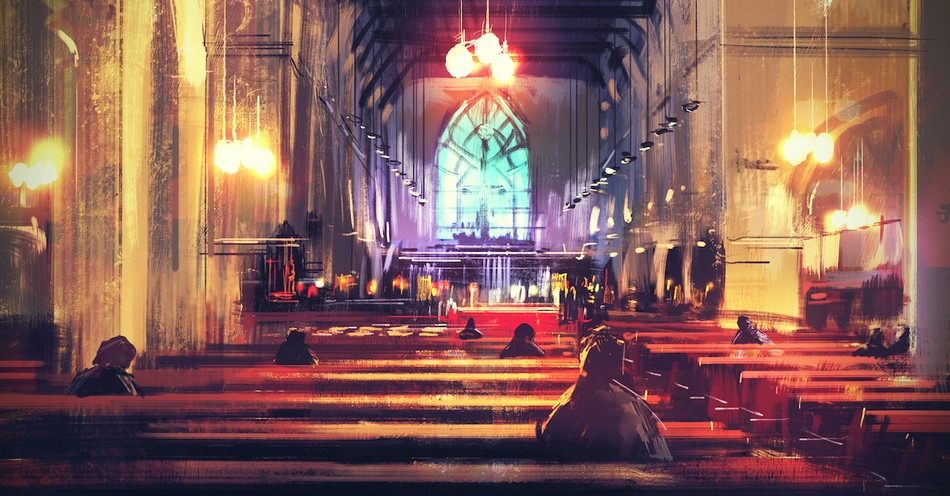The Bible teaches that the church, as established by Christ Himself, will last throughout this age and into eternity (Matthew 16:18; Ephesians 3:11; Revelation 7:9-17). However, individual local churches tend to be in existence for a noticeably short period of time.
The oldest church in the United States is said to be the San Miguel Mission in Santa Fe, New Mexico that can trace its roots back to about 1610. There are other American churches, mostly located in eastern states, that can trace their roots back to the mid and late 1600s.
The histories of local churches in this country pale in comparison, however, to a listing of the oldest churches around the world, some of which boast of a heritage that began in the first or second centuries.
According to several sources, the oldest church in the world is the Dura-Europos Church in modern-day Syria, whose building was constructed somewhere between 233 and 256 AD.
Thanks to the work of historians and archaeologists, this specific first-century church provides very real lessons for today’s local churches.
A quick look at some of the discoveries made at that site disclose some particularly important characteristics and functions of this historic church that are applicable for contemporary churches as well.
Important Characteristics of the World’s Oldest Church
According to sources, the Dura-Europos Church was excavated in the 1920s and 1930s and is located in an area of Syria that was recently controlled by the occupation of ISIS soldiers and sympathizers.
However, there are some fascinating aspects of this building that have revealed five essential functions of this early church.
1. The church consisted of families that were dedicated to serving the Lord. It is important to note that this church building was probably originally constructed as a house, and then was renovated to serve as a meeting place for the local assembly of believers.
This indicates that family units were important in this church, at least to the extent that the former owners of this structure were committed to using their home for church purposes. Of course, there is also biblical precedent for individual homes being used for church purposes.
Examples include the church prayer meeting in the home of Mary, the mother of John Mark (Acts 12:12), and Aquila and Priscilla opening their house for the church to meet (1 Corinthians 16:19).
From the time when Christ instituted His church following Pentecost, the church made it a practice to gather in homes (Acts 2:46).
History then records what must have been a transition for the church from meeting in the homes of members to building structures that were uniquely designed and constructed for local churches to assemble their people together.
Up until that time, household members willingly served the Lord by providing use of their own homes for church meetings. The Dura-Europos Church may have been one of the first buildings in the entire world that was ultimately used exclusively by a local church.
2. The church made gathering a top priority. The excavation of the Dura-Europos building site showed that the house was adjoined to a separate hall-like room, which probably served as a meeting space for church attendees.
It is obvious then that gatherings were a priority for the early church. Meeting in homes facilitated fellowship (Acts 2:46), which probably included events like the Lord’s Supper and even feasts and meals together.
But the size of a normal family dwelling place usually prohibited large group gatherings. That is probably a major reason why churches began to build their own meeting sites.
Early churches understood the biblical importance of assembling (Hebrews 12:25), and so they decided to construct facilities to meet. As churches grew, their need for bigger meeting space also increased.
3. The church was committed to discipleship and growth. Another quite enlightening characteristic of the world’s oldest church was that a well-developed baptistry was discovered by archaeologists within the building.
There is no doubt that the Dura-Europos Church was following the Lord’s Great Commission (Matthew 28:19-20).
Not only did this church outgrow its household facility, but it must have also been seeing people come to Christ — and therefore built a baptistry to fulfill that aspect of Christ’s command.
It is thrilling to realize that this church was committed to evangelism and making disciples. They must have seen the biblical ordinance of baptism as an integral part of their worship to the Lord.
4. The church utilized the arts in worship. There is a fourth revealing fact about this ancient Syrian church. Excavators discovered artwork around the baptistry that demonstrated the importance they placed on worship to the Heavenly Father.
Ruins of old “frescoes” were uncovered that depicted scenes from both the Old and New Testaments.
Without question, these archaeological discoveries proved that the Dura-Europos people understood the significance of honoring the Lord and His work throughout the centuries of His creation.
They understood the value of the scriptural narrative and created lasting visual aids to assist their people in worship to the lasting power of Almighty God and His work in and through the lives of His people.
5. The church understood the importance of the study of Scripture. There was one other discovery in the ancient ruins of this first-century church building. Fragments of parchment scrolls with Hebrew texts were also found.
These pieces of the writings from some of the early Church Fathers provide another clue as to the purpose of this church’s gatherings. This church met to study God’s Word together.
This church made learning from credible voices about the teachings of Christ another top priority and utilized written tools to help people grow in Christ.
There can be no confusion. The construction of a meeting hall, plus the remnants of scrolls provide tangible evidence that a key element of early church life was the teaching and preaching of the Bible.
What Happened to the World’s Oldest Church?
The sad thing about using the Dura-Europos Church as an example for churches today is that this church is not in existence.
Its building, once evidence of a vibrant and growing congregation, lies in ruins and was only discovered by persistent archeologists and historians who were willing to dig through multiple layers of dirt to find this ancient structure.
One would think that individual local churches that were established and grounded on biblical principles, like the five characteristics of the Dura-Europos Church as described above, would endure and flourish until Christ’s return. But this local church no longer exists.
History records that the city of Dura-Europos, located then above the right bank of the Euphrates River was captured by the Sasanian Empire after a siege in AD 256–257, and its population was deported. After that, the city was abandoned and was ultimately covered by sand and mud.
There are multiple reasons why an individual local church might lose its vitality and relevance. In this case, the culture completely changed due to a violent overthrow by a powerful enemy neighbor. The city, as well as this church building within it, disappeared from sight.
Lessons for Today’s Church
This should not discount the important and biblical lessons for today’s church from the world’s oldest church. There was a time when the Dura-Europos Church was a vital part of the general culture around it.
Built to be a personal house, the building outgrew its walls due to the growth of the church that met there, and a larger meeting hall and baptistry were added to facilitate the expansion of this church’s congregation.
It is also obvious that this church wanted to gather together, and built an addition to their building to allow for that to happen.
The discovery of paintings that depicted scenes of Scripture as well as fragments of parchments written by Church Fathers showed the Dura-Europos people’s commitment to worship and spiritual growth.
These characteristics are all priorities that should be implemented by today’s church as well. Each local church must gather to worship and study God’s Word.
Churches must also disciple new believers and baptize them as a public demonstration of their faith in Christ — and all Christ-followers can serve the Lord by using whatever they have (including their homes) for Him.
It is the “universal church,” the body of Christ that will last until eternity. Individual local churches may go through times of both growth and decline, the point remains for each church to stay faithful to the mission Christ left His followers here on earth to do.
For further reading:
10 Oldest Churches in the World
The Earliest Christian House Church, With the Most Ancient Christian Paintings
What Really Happened at Pentecost?
What Lessons Should We Learn from Church History?
Can the Church Still Be Connected Without a Building?
What Does it Mean to be a Disciple of Christ?
Photo Credit: ©iStock/Getty Images Plus/Grand Failure




